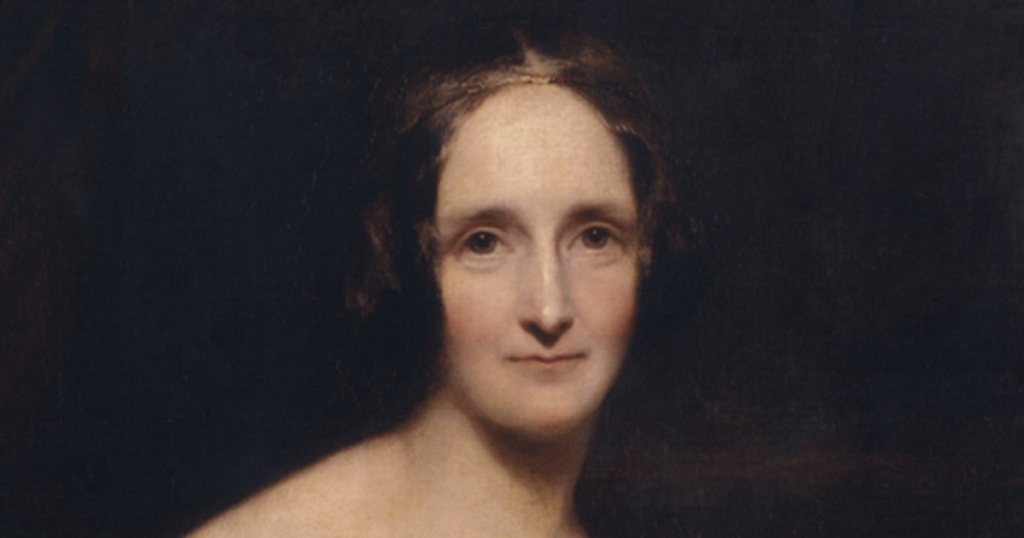Monstrous Achievement
Two hundred years on, a writer’s cautionary tale still captivates

In Search of Mary Shelley: The Girl Who Wrote Frankenstein by Fiona Sampson; Pegasus, 304 pp., $28.95
When Mary Shelley, having lost her adored and difficult husband and three of her children in Italy, at last returned to England in 1823, she chanced to ask an acquaintance for advice on choosing a school for her surviving son. “Oh, send him somewhere where they will teach him to think for himself!” her friend said. Mary replied heartily: “Teach him to think for himself? Oh, my God, teach him rather to think like other people!”
This year marks the bicentennial of the publication of Frankenstein, Mary Shelley’s classic cautionary tale of scientific hubris and recklessness. Therefore, we must needs have a new biography of the teenage author, who was inspired by ghost stories shared among friends on a stormy night in Switzerland. Because she was the daughter of famous parents—Mary Wollstonecraft, feminist icon, and the radical philosopher and journalist William Godwin—and also because at the age of 16, she ran away with Percy Bysshe Shelley, a young, married poet who had already kicked over the traces of an expensive education and a repressive aristocratic parent, Mary lived in the shadow of who she was and whom she knew. Now, two centuries after she imagined a monster and the mad scientist who created him, more people have read her novel than the essays of her radical parents and the poems of her husband combined. That she was 19 when Frankenstein was published adds a piquancy to the fame; it came early, and as often happens in such cases, though Mary wrote several books and lived off her pen throughout her life, she never surpassed this first soaring imaginative flight.
Fiona Sampson, an esteemed British poet and author in her own right, addresses the challenge of a new inquiry into Mary’s not-unexamined life (there are several extant biographies) in an oddly defensive introduction, declaring her intention to show us Mary Shelley as she has not been seen before, “closer to us, and closer again, until she’s hugely enlarged in close-up. I want to see the actual texture of her existence, caught in freeze-frame.” It’s an intriguing method, and it serves both the biographer and her subject well.
Sampson opens each chapter with a visual scene meant to bring Mary and her world into tighter focus. She gives us Mary’s birth, followed hard on by the death of her famous mother from puerperal fever; the meeting, described by her future husband’s best friend, Thomas Jefferson Hogg, when Mary summoned Percy to a tryst through a partially opened door in her father’s library; the elopement, with Percy and the pregnant, seasick Mary collapsed in each other’s arms on the schooner deck during a stormy night passage across the English Channel; the group of friends gathered in the drawing room of Lord Byron’s villa on Lake Geneva, electrifying each other with ghost stories; the arrival of family friend Edward Trelawny with the news that the drowned bodies of Percy and his companion Edward Williams had washed up on the shore in Livorno—all these set pieces illuminate Mary in what should be a revelatory light.
But Sampson won’t stand back and let the reader marvel at these beautifully drawn scenes. She’s like a painter who doesn’t know when to put down the brush. She insists upon reworking her canvas, over and over, until Mary loses color and vitality, and finally fades from view.
In Hogg’s description of Mary’s rendezvous with Shelley, for example, he mentions that Mary is wearing a tartan dress, “an unusual dress in London at that time.” Sampson pounces upon the detail of the tartan: “This is where we can recognise Mary.” Thence follows a long series of speculations about why Mary is wearing an “unusual” dress. It’s June in London, too hot for wool, but Mary has spent time in Dundee, Scotland, and might well be making a political statement. Maybe she feels the tartan highlights her Scots coloring. Or, Sampson continues, “Perhaps Mary is aware, after all, of how unusual her outfit is, and is determined to be special. Or else, quite the opposite: in this cash-strapped household the middle daughter is having to wear her badly chosen new dress, suitable or not, until it is worn out.”
Sampson continues these increasingly bizarre and conflicting speculations as she rambles through the rest of Mary’s life. She even resorts to unhelpful psychological jargon: Percy is bipolar, Mary suffers from posttraumatic stress. Recounting a time when Shelley, avowed atheist and free-love enthusiast, pressed Mary to have sex with Hogg, Sampson offers a numbered list of nine potential motives. To name a few: Shelley truly believes in free love; he feels trapped by Mary; he’s distracted by her stepsister; he’s bisexual; he and Hogg are both bisexual, but there are laws against sodomy, so “this is a way for them to sleep (or almost to sleep) together.”
What’s grievously missing here is any real sense of how Mary apprehended the world as she found it. Sampson does quote from Mary’s journals and letters, allowing us to hear her voice, but never at any length. I wish I could say the lively quotation that opens this review appears in the pages of Sampson’s biography, but it does not. It comes from a review of a 19th-century biography of Percy Shelley. The reviewer is Matthew Arnold, the year 1888, and Arnold reports Mary’s remark as gossip he heard from a friend. This is where we can recognize Mary Shelley: acerbic, witty, quick, and very clear about what she sacrificed when she threw in her lot with a radical poet who insisted on thinking for himself.

